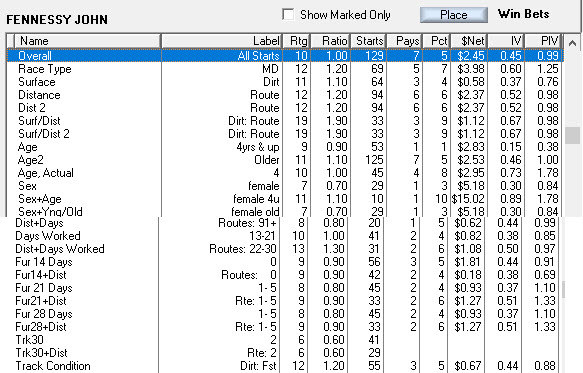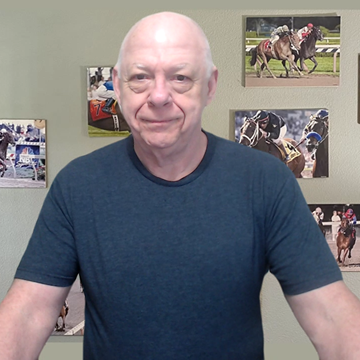Comments
-
My New Software is coming: The STUDIO
Oh, and I apologize for my tone in my original reply.
I'm just amazed at how many people call me and say stuff like, "I only play 3 days a month. Can I get your software for free?"
But nevertheless, you did not deserve my tone, so I apologize. -
My New Software is coming: The STUDIOThat's crystal clear.
Trust me when I say that the $12 per month will be the best $12 you ever spent in terms of what you get.
We're trying to build something special here.
(And I am not talking just about the software.)
You'll either buy in or not.
For the record, my biz model is not the same as HTR.
He does it his way and I do it mine.
I like mine.
(He likes his.)
What matters to you is which one you like.
Best to you, Slim. -
What being a member here has done for meI thought Jackie's Warrior was a good bet at even money. — RanchWest
Bring that up tonight and we can look at that race - whichever one it was. -
My New Software is coming: The STUDIODave: I don't use HSH. How much will it cost me for the new software and data fees? — Jim Michalak
There will be several levels.
Still working on pricing, but levels are:
1. No-Data (worksheets and organization) $79 + $12 a month
2. Basic (HDW) $147 + $12 per month
3. Premium (HDW) $477 + $12 per month
4. Pro (HDW) Includes HSH $1,600 + $12 per month
The $12 per month is for subscription to this website which includes:
Products from our store.
Special stuff like picks from our software, etc.
A lot for very little.
If you have the software, it includes some very cool add-ins.
HDW Downloads are $142 per month from HDW.
All tracks, with results. -
Fellow Won the Derby Trifecta with ALL button - Does that count?I’ve heard better lucky than good. — Steven
Point taken.
If only that worked it the long run, right? LOL -
Paceline Selection Systems & MethodsLet's catch up after this weekend.
I'd really like to run some ideas past you - especially on the note taking. -
What being a member here has done for meWhile big scores are really nice, the every day bread and butter is winners that look to be sound wagers. — RanchWest
I think the above quote is really the game changer.
It is a subtle difference, but do you see how the UNSPOKEN FOCUS has shifted from price=value to value=value no matter the price?
This is how one becomes a long-term winner as opposed to being a Slot Machine Horse Player.
(i.e. one who depends upon luck to have a winning day and almost never has a winning month.)
And it is amazing how fast the transition occurs: Usually just takes A FEW DAYS. -
Paceline Selection Systems & MethodsExperience does help. But I'd have to say that my experience with Thorograph played a big part. Especially the concepts around form cycles — Tony Kofalt
Tell us as much as you can, please, about that process.
Or links to TGraph docs.
BTW, HSH does have built in Rag-style numbers.
Do you like those? -
Paceline Selection Systems & MethodsIs that something you are doing through HSH? Is there some automation involved in the form cycle weights or is that pretty much subjective? — RanchWest
HSH supports that - even via the systems.
(Tony hasn't used HSH for a long time.) -
What being a member here has done for meGentlemen, THIS is what I want YOU GUYS to share with our handicapping world.
-
What being a member here has done for me@RanchWest
You are awesome, man!
Love that you are making real VALUE selections.
I look forward to you teaching what you know real soon. -
What about jockeys?Love the story.
I've heard similar before.
Had an old friend/client (early '90s) Jeff G. who had Robbie Davis' book for a while. The stories I got were really amazing. -
What about jockeys?I think it would even better if broken down by surface/distance as well. — Tom
Oh, we'll do WAY MORE than that.
I'm going to re-do our trainer stats as well, and those are already mind-blowing.
We have the usual stuff like---

But we've also got PERFORMANCE STATS.

But I want to re-do them ad add a couple hundred more factors. -
What about jockeys?It's in the Bris Ultimate PPs.
As Richie Migliore says about early speed as a weapon,"They have to go where I've already been." — Tom
Excellent.
A feature we need in The Studio. -
Paceline Selection Systems & MethodsI asked Rich about this (above), but I should have asked you. I am a confused on the need to Sort by. Can you explain a little or give an example? Thanks for sharing! — Biniak
Easy.
You have 10 pacelines for a horse.
There are 3 issues:
1. Which pacelines are QUALIFIED?
2. How many do we want to SELECT?
3. How should we ORDER them to determine which to select?
1. Is similar surface, similar distance, lengths behind/ahead.
2. Is a determination that should change depending upon the confidence we have in the selection.
3. Is what you asked about.
Imagine you have 10 pacelines.
Step 1 slims that down to (say) 3 pacelines.
If it slimmed it down to just one, you would need a sort, right?
But with 3 pacelines, you need some way to ORDER them.
Sort by:
most recent
closest distance
fastest final time
This particular sort will really only require "Most Recent" because there will never be a tie (unless the horse raced twice in one day. - It HAS happened.)
But some of the other conditions require more sorts.
THE POINT
You will sort and take the TOP LINE (or top 2, 3 or whatever).
Hope this explains it. -
Paceline Selection Systems & MethodsMy mistake.
I forgot that I changed the rules about 5 years ago.
Had to go look at the code.
It appears that I changed it to 1st or 2nd, or less than 1.00 lengths.
Good catch. -
Paceline Selection Systems & MethodsOkay, I'm lost. I don't understand how the two example horses earned a G for the races marked. There's something I don't understand here. — RanchWest
Because they won those races.
Or, they finished so close that it counts as a win.
More specifically, #6 won her 5th race back which was:
- Same surface as today.
- Similar distance as today.
- Same or higher class as today.
What are you not understanding about that? -
Paceline Selection Systems & MethodsI'm trying to follow along. Should that be 2 lengths? And maybe 3 in a route? — RanchWest
No. It is exactly as I said:
G=Won on today's surface, at today's approximate distance, at today's class or higher.
(Losing by a neck or less counts as a win.) — Dave Schwartz
G=Finish within a neck or a win. -
What about jockeys?I know that I talked to a trainer at Lone Star who told me that if a jockey didn't try to go to the front end on his horses, they wouldn't be riding for him long. — RanchWest
@Tony Kofalt
I am under the impression that most trainers tell the jockey how to ride the horse and, if the jockey ignores his wishes, he doesn't get mounts.
Is that true?
BTW, are you still a jockey agent?
Dave Schwartz

Start FollowingSend a Message

